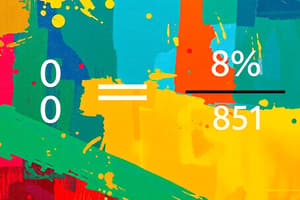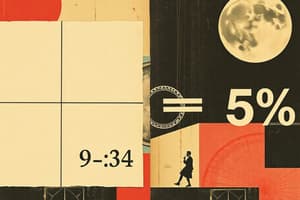Podcast
Questions and Answers
Converting fractions involves multiplying both the numerator and denominator by the same non-zero number to maintain the value of the fraction but change its appearance. For example, converting (\frac{2}{3}) to (\frac{4}{6}) is achieved by multiplying the numerator and denominator by __________.
Converting fractions involves multiplying both the numerator and denominator by the same non-zero number to maintain the value of the fraction but change its appearance. For example, converting (\frac{2}{3}) to (\frac{4}{6}) is achieved by multiplying the numerator and denominator by __________.
2
When dealing with unlike fractions like (\frac{1}{2}) and (\frac{3}{4}), finding the least common multiple (LCM) of their denominators helps in achieving a __________ denominator.
When dealing with unlike fractions like (\frac{1}{2}) and (\frac{3}{4}), finding the least common multiple (LCM) of their denominators helps in achieving a __________ denominator.
common
By dividing the larger denominator by the smaller one, you get the factor of the difference. Multiply the divisor by the common denominator, then add it to the other denominator to find the __________.
By dividing the larger denominator by the smaller one, you get the factor of the difference. Multiply the divisor by the common denominator, then add it to the other denominator to find the __________.
LCM
Converting fractions can also involve converting them into __________ representations.
Converting fractions can also involve converting them into __________ representations.
Simplifying fractions is a process of reducing them to their __________ form.
Simplifying fractions is a process of reducing them to their __________ form.
To convert a fraction into a decimal, simply divide the numerator by the denominator using ______ division.
To convert a fraction into a decimal, simply divide the numerator by the denominator using ______ division.
Equivalent fractions are fractions with the same value, such as ______, etc.
Equivalent fractions are fractions with the same value, such as ______, etc.
The new fractions have the common denominator ______.
The new fractions have the common denominator ______.
Simplifying fractions involves reducing the fraction to its lowest terms by finding the greatest common divisor (GCD) of the numerator and the denominator and dividing both by it. For example, simplifying rac{22}{33} to its lowest terms: rac{22}{33} = rac{2 imes 11}{3 imes 11} = ______.
Simplifying fractions involves reducing the fraction to its lowest terms by finding the greatest common divisor (GCD) of the numerator and the denominator and dividing both by it. For example, simplifying rac{22}{33} to its lowest terms: rac{22}{33} = rac{2 imes 11}{3 imes 11} = ______.
When converting fractions to equivalent fractions, you can use the same method as for converting fractions, where you multiply both the numerator and the denominator by the same ______ number.
When converting fractions to equivalent fractions, you can use the same method as for converting fractions, where you multiply both the numerator and the denominator by the same ______ number.
Flashcards are hidden until you start studying
Study Notes
Fractions can represent parts of a whole or ratios between two numbers. Converting fractions means changing one fraction into another equivalent fraction or decimal representation. In this article, we will discuss how to convert fractions with a focus on common denominators, decimal fractions, equivalent fractions, and simplifying fractions.
Converting Fractions
Conversion usually involves multiplying both the numerator and denominator by the same non-zero number. This process maintains the value of the fraction but changes its appearance. For example, converting (\frac{2}{3}) to (\frac{4}{6}) is achieved by multiplying the numerator and denominator by (2):
[ \begin{align} \frac{2}{3} &= \frac{(2 \times 2)}{(3 \times 2)} \ &= \frac{4}{6} \end{align} ]
This new fraction, (\frac{4}{6}), is equivalent to (\frac{2}{3}).
Common Denominators
When dealing with unlike fractions ((\frac{1}{2}, \frac{3}{4})), finding the least common multiple (LCM) of their denominators helps in achieving a common denominator. By dividing the larger denominator by the smaller one, you get the factor of the difference. Multiply the divisor by the common denominator, then add it to the other denominator. Finally, divide the result by the sum of the two denominators.
For instance, consider converting (\frac{2}{3}) and (\frac{3}{4}) to equivalent fractions with a common denominator:
[ \begin{align} \text{LCM}(3,4) &= 12 \ \frac{2}{3} &\rightarrow \frac{2 \times 4}{3 \times 4} = \frac{8}{12} \ \frac{3}{4} &\rightarrow \frac{3 \times 2}{4 \times 2} = \frac{6}{8} \ \end{align} ]
The new fractions have the common denominator (12). However, they can be further converted to simplify them.
Decimal Fractions
To convert a fraction into a decimal, simply divide the numerator by the denominator using long division. For example, converting (\frac{5}{3}) to decimal form:
[ \begin{align} \frac{5}{3} &= 1.\overline{6} \ \end{align} ]
Here, the overbar indicates repeating decimals.
Comparison of Fraction and Decimal Forms
Fraction and decimal representations provide different ways of representing numbers. While fractions show relationships between parts within a whole, decimals represent portions without considering the parts involved. They correspond to each other as follows:
[ \frac{a}{b} = \frac{a}{10^n} ]
where (a) is the numerator, (b) is the denominator, and (n) is the place value.
Equivalent Fractions
Equivalent fractions are fractions with the same value, such as (\frac{1}{1}, \frac{2}{2}, \frac{3}{3}, \frac{4}{4},) etc. They have different numerators and denominators but represent the same ratio. When converting fractions to equivalent fractions, you can use the same method as for converting fractions, where you multiply both the numerator and the denominator by the same non-zero number.
Simplifying Fractions
Simplifying fractions involves reducing the fraction to its lowest terms. This means finding the greatest common divisor (GCD) of the numerator and the denominator and dividing both by it. The result is a simplified fraction. For example, simplifying (\frac{22}{33}) to its lowest terms:
[ \begin{align} \frac{22}{33} &= \frac{2 \times 11}{3 \times 11} \ &= \frac{2}{3} \end{align} ]
In this case, the greatest common divisor of (22) and (33) is (11), which is divided by both the numerator and denominator to obtain the simplified fraction (\frac{2}{3}).
Conclusion
Converting fractions involves various operations such as finding common denominators, decimal representations, equivalent fractions, and simplifying fractions. Understanding these concepts can help you effectively work with fractions and understand their relationships to each other and to decimals. By applying these techniques correctly, you can accurately convert fractions and simplify them for easier understanding and manipulation.
Studying That Suits You
Use AI to generate personalized quizzes and flashcards to suit your learning preferences.




